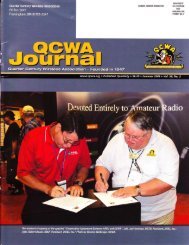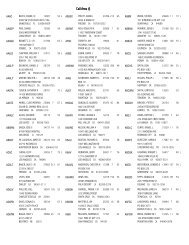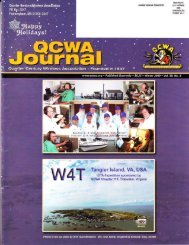You also want an ePaper? Increase the reach of your titles
YUMPU automatically turns print PDFs into web optimized ePapers that Google loves.
cost A high grade 0f this type of protector that has higher current pro-<br />
tection and built-in telephone line protection is also commonly available<br />
at much higher cost Some companies like Polyphaser and Brickwall<br />
offer surge protection with much improved performance.<br />
There are two main types of surge protectors:<br />
. One type of protector dumps surge current into the SPGP via the<br />
use of Metal 0xide Varistors (MOtf . This type requires an excellent<br />
ground installation with wide grounding straps. lf y0u use this type of<br />
system to dump current into the neutral conductor of the house wiring,<br />
it will not perform well due to the very large inductance encountered in<br />
the path to ground, This type of protector is only limited by the size of<br />
the MOV devices being used and the quality of the external grounding<br />
system. Mov devices can fail under extreme surges,<br />
o The non-MOV type circult that uses a large inductor t0 stop most<br />
surges and dumps excessive current progressively into a bank of<br />
capacitors, Typical circuits for this type of protector can be found in TCA<br />
Hotlink, 11. They can be mounted directly on the SPGP for convenience<br />
but do not rely on the SPGP for protection. This protector is limited by<br />
the amount of capacitance used to store the surge current, These units<br />
are not likely to fail since they do not contain MOV devices. However,<br />
they do contain switches and other components.<br />
The decisron about which type to purchase is not easy. lf you live in an<br />
area which is not prone to lightning storms, a very high quality computer<br />
grade protector will probably suffice. However, if Iightning js a real<br />
problem, you should select a high capacity MOV type or the non-MOV<br />
type as described above, lf your ground system is not ideal due to the<br />
location of the radio with respect to the ground, it is best to use the<br />
non-MOV type circuit as that type does not rely on dumping large<br />
amounts of current into the ground,<br />
Coaxial Type Protectors<br />
There are three basic types of coaxial surge protectors: the dc-blocked<br />
high-pass filter, the dc-blocked quarter wave siub and the straight gas<br />
tube (SGT),non-dc-blocked.<br />
The Straight Gas Tube (SGI) (Non-D0-Blocked)<br />
The SGT consists of a gas tube connected across the coaxial cable.<br />
When the surge voltage exceeds a certain level (around 200 Volts for<br />
low power applications) the gas tube fires and shorts out in a fail safe<br />
mode. The tube must then be replaced, The characteristics of the SGT<br />
are:<br />
. There is no attenuation of lightning frequencies (20 Klz to l MHz)<br />
. The SGT is inherently wide band.<br />
. The SGT might not protect the receiver if the maximum acceptable<br />
input voltage of the receiver is lower than the SGT firing voltage. This is<br />
difficult to check as most amateur radio transceivers do not include the<br />
maximum allowed input voltage in the specifications<br />
The Quarter Wave Stub (DC-Blocked)<br />
The quarter wave stub is simply a shorted stub connected in parallel<br />
with the transmission line. Hence, it has excellent low frequency proper-<br />
ties while appearing as a low loss band pass filter at the desired oper-<br />
ating frequency. lts characteristics are:<br />
. The device is narrow band (approximalely 20% band width)<br />
. The device is passive so there are no components to change rn<br />
case of large surges. lt will not normally fail, even in extreme conditions.<br />
o lt filters out lightning frequencies,<br />
The High-Pass Filter (DC-Blocked)<br />
The high-pass filter type consists of a shunt connected inductor and a<br />
series connected capacitor to form a high-pass filter. lts characteristics<br />
are:<br />
o lt filters out lightning frequencies and is desrgned to do so in an<br />
optimum fashion. The Polyphase DSX model attenuates lightning frequencies<br />
by 89 dB. The quarter wave stub attenuates lightning frequen-<br />
cies by approximately 55 dB.<br />
. The device is passive so there are no components to change in<br />
case of large surges. lt will not normally fail, even in extreme conditions.<br />
Other Configurations<br />
This article discussed the basic set-up which consisted of a single<br />
coaxial cable feeding an antenna that was mounted on a grounded<br />
tower. There are many other arrangements that are often used, Some<br />
systems have a low noise amplifier mounted at the top of the tower<br />
where power must be fed to the amplifier. ln this case the coaxial surge<br />
protector will be mounted at the top to the tower between the antenna<br />
and the amplifier. 0ften, there is an antenna rotator mounted at the top<br />
which requires DC power. The cables that feed the power to the rotator<br />
must also be protected. These and other configurations are discussed in<br />
TCA Hotlinks I -5<br />
An inverted V GSRV or dipole antenna will use a Balun that is mount-<br />
ed at or near the antenna feed point. ln this case the coaxial surge<br />
protector will be mounted on the SPGP<br />
A vertical antenna with ground radials can be set up in the same way<br />
as the tower mounted system. The coaxial cable is first connected to a<br />
single grounded feedthru and then to the house panel as described<br />
above,<br />
A Common Pitfall<br />
An amateur who is using a non-protected system, disconnects his/her<br />
expensive transceiver from the antenna coaxlal cable and places the<br />
cable on the floor of the radio shack when a storm is approaching. This<br />
simple act violates safety guidelines that have been given to us by oro-<br />
fessionals. Here is what can happen. The storm can cause an arc 0n<br />
the lpen ended coaxial cable in the han shack, create hot plasma in<br />
the room and possibly set fire to the house.<br />
Further Study Using TCA Hotlinks<br />
Further information is provided via TCA hotlinks which are easily<br />
accessed via the RAC website. For this information, please visit http:i/<br />
www.rac.caltca. Hotlinks make it unnecessary to type URL addresses<br />
into your computer and provide you with calculators and other support<br />
that demonstrates the ideas presented in the articles. The following<br />
hotlinks for this article are available on the RAC site.<br />
TCA Hotlink, 1 PolyPhaser Technical Literature<br />
htto ://www. oolvphaser. com/<br />
TCA Hotlink, 2 An overview of Lightning Protection for Ham Radio<br />
Stations<br />
http://www. polvphaser.com/NR/rdonlvres/C1 565001 -FB1 A-4AC2-<br />
\.lO QCWAJournal . Wlnter 2aO7 t wwwqcwa.org



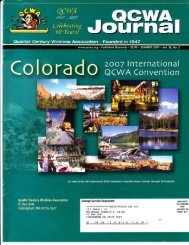
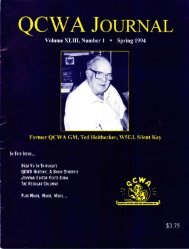
![11{J hI EfifSIt]E I]E - Quarter Century Wireless Association](https://img.yumpu.com/11816560/1/190x245/11j-hi-efifsite-ie-quarter-century-wireless-association.jpg?quality=85)
